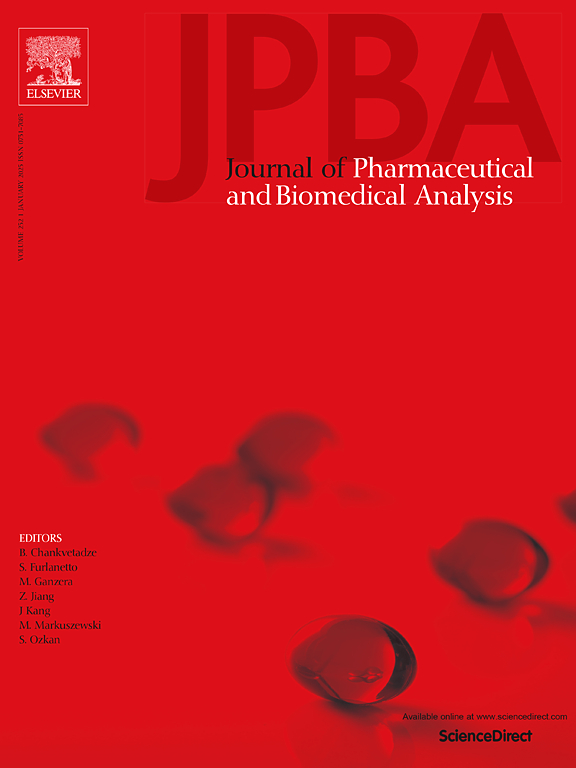姜黄素作用下HepG2细胞表面CD95受体的单分子识别
IF 3.1
3区 医学
Q2 CHEMISTRY, ANALYTICAL
Journal of pharmaceutical and biomedical analysis
Pub Date : 2025-04-24
DOI:10.1016/j.jpba.2025.116917
引用次数: 0
摘要
肝细胞癌(HCC)是世界范围内的一个严重问题。已发表的报道表明,CD95受体的异常表达在肝癌细胞凋亡中起关键作用。虽然姜黄素在诱导肝癌细胞凋亡方面表现出了良好的前景,但其在这一过程中对CD95表达的直接影响尚未得到充分研究。本研究旨在利用荧光染色、单分子力谱(SMFS)和单分子识别成像(SMRI)等技术,定量评估不同浓度姜黄素处理的HepG2细胞中CD95受体的表达。荧光染色结果显示姜黄素处理后CD95表达显著增加。首次利用SMFS和SMRI技术直接揭示了CD95在细胞膜上的结合位点,随着姜黄素浓度的增加,结合位点的数量也在增加。此外,姜黄素增强了抗体修饰探针与CD95的结合力,表明姜黄素增加了CD95结合位点的数量和亲和力。该研究为姜黄素诱导的cd95介导的肝癌细胞凋亡提供了新的见解,并强调了AFM技术在研究药物机制方面的潜力。总的来说,这些发现可能为肝癌的创新治疗策略提供信息,并改善药物设计过程。本文章由计算机程序翻译,如有差异,请以英文原文为准。
Single molecule recognition of CD95 receptors on the surface of HepG2 cells under the curcumin
Hepatocellular carcinoma (HCC) is a serious concern worldwide. The published reports showed that aberrant CD95 receptor expression plays a critical role in apoptosis in liver cancer. While curcumin has shown promise in inducing apoptosis in liver cancer cells, its direct effects on CD95 expression during this process have not been thoroughly investigated. This study aims to quantitatively assess the expression of the CD95 receptor in HepG2 cells treated with different concentrations of curcumin using techniques such as fluorescence staining, single-molecule force spectroscopy (SMFS), and single-molecule recognition imaging (SMRI). Fluorescence staining results indicate a significant increase in CD95 expression following curcumin treatment. For the first time, SMFS and SMRI techniques were used to directly reveal the binding sites of CD95 on the cell membrane, with the number of binding sites increasing as the curcumin concentration increased. Additionally, the binding force between an antibody-modified probe and CD95 was strengthened with curcumin treatment, suggesting that curcumin enhances both the quantity and affinity of CD95 binding sites. This study provides new insights into curcumin-induced CD95-mediated apoptosis in liver cancer cells and highlights the potential of AFM techniques for investigating drug mechanisms. Overall, these findings may inform innovative therapeutic strategies for liver cancer and improve drug design processes.
求助全文
通过发布文献求助,成功后即可免费获取论文全文。
去求助
来源期刊
CiteScore
6.70
自引率
5.90%
发文量
588
审稿时长
37 days
期刊介绍:
This journal is an international medium directed towards the needs of academic, clinical, government and industrial analysis by publishing original research reports and critical reviews on pharmaceutical and biomedical analysis. It covers the interdisciplinary aspects of analysis in the pharmaceutical, biomedical and clinical sciences, including developments in analytical methodology, instrumentation, computation and interpretation. Submissions on novel applications focusing on drug purity and stability studies, pharmacokinetics, therapeutic monitoring, metabolic profiling; drug-related aspects of analytical biochemistry and forensic toxicology; quality assurance in the pharmaceutical industry are also welcome.
Studies from areas of well established and poorly selective methods, such as UV-VIS spectrophotometry (including derivative and multi-wavelength measurements), basic electroanalytical (potentiometric, polarographic and voltammetric) methods, fluorimetry, flow-injection analysis, etc. are accepted for publication in exceptional cases only, if a unique and substantial advantage over presently known systems is demonstrated. The same applies to the assay of simple drug formulations by any kind of methods and the determination of drugs in biological samples based merely on spiked samples. Drug purity/stability studies should contain information on the structure elucidation of the impurities/degradants.

 求助内容:
求助内容: 应助结果提醒方式:
应助结果提醒方式:


